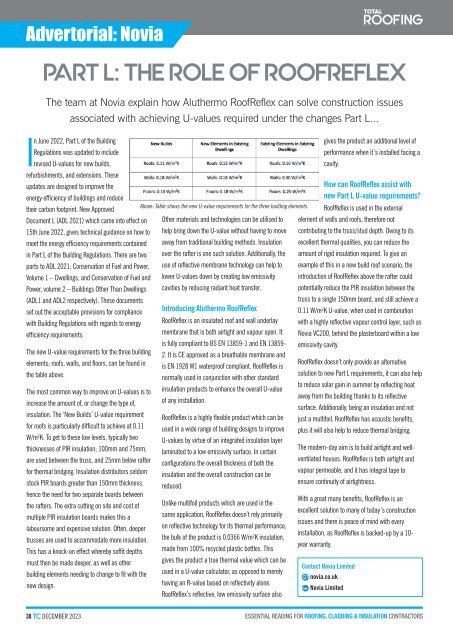December 2023
Create successful ePaper yourself
Turn your PDF publications into a flip-book with our unique Google optimized e-Paper software.
Advertorial: Novia<br />
PART L: THE ROLE OF ROOFREFLEX<br />
The team at Novia explain how Aluthermo RoofReflex can solve construction issues<br />
associated with achieving U-values required under the changes Part L...<br />
In June 2022, Part L of the Building<br />
Regulations was updated to include<br />
revised U-values for new builds,<br />
refurbishments, and extensions. These<br />
updates are designed to improve the<br />
energy efficiency of buildings and reduce<br />
their carbon footprint. New Approved<br />
Document L (ADL 2021) which came into effect on<br />
15th June 2022, gives technical guidance on how to<br />
meet the energy efficiency requirements contained<br />
in Part L of the Building Regulations. There are two<br />
parts to ADL 2021; Conservation of Fuel and Power,<br />
Volume 1 – Dwellings, and Conservation of Fuel and<br />
Power, volume 2 – Buildings Other Than Dwellings<br />
(ADL1 and ADL2 respectively). These documents<br />
set out the acceptable provisions for compliance<br />
with Building Regulations with regards to energy<br />
efficiency requirements.<br />
The new U-value requirements for the three building<br />
elements; roofs, walls, and floors, can be found in<br />
the table above.<br />
The most common way to improve on U-values is to<br />
increase the amount of, or change the type of,<br />
insulation. The ‘New Builds’ U-value requirement<br />
for roofs is particularly difficult to achieve at 0.11<br />
W/m²K. To get to these low levels, typically two<br />
thicknesses of PIR insulation; 100mm and 75mm,<br />
are used between the truss, and 25mm below rafter<br />
for thermal bridging. Insulation distributors seldom<br />
stock PIR boards greater than 150mm thickness,<br />
hence the need for two separate boards between<br />
the rafters. The extra cutting on site and cost of<br />
multiple PIR insulation boards makes this a<br />
laboursome and expensive solution. Often, deeper<br />
trusses are used to accommodate more insulation.<br />
This has a knock-on effect whereby soffit depths<br />
must then be made deeper, as well as other<br />
building elements needing to change to fit with the<br />
new design.<br />
Above: Table shows the new U-value requirements for the three building elements.<br />
Other materials and technologies can be utilised to<br />
help bring down the U-value without having to move<br />
away from traditional building methods. Insulation<br />
over the rafter is one such solution. Additionally, the<br />
use of reflective membrane technology can help to<br />
lower U-values down by creating low emissivity<br />
cavities by reducing radiant heat transfer.<br />
Introducing Aluthermo RoofReflex<br />
RoofReflex is an insulated roof and wall underlay<br />
membrane that is both airtight and vapour open. It<br />
is fully compliant to BS EN 13859-1 and EN 13859-<br />
2. It is CE approved as a breathable membrane and<br />
is EN 1928 W1 waterproof compliant. RoofReflex is<br />
normally used in conjunction with other standard<br />
insulation products to enhance the overall U-value<br />
of any installation.<br />
RoofReflex is a highly flexible product which can be<br />
used in a wide range of building designs to improve<br />
U-values by virtue of an integrated insulation layer<br />
laminated to a low emissivity surface. In certain<br />
configurations the overall thickness of both the<br />
insulation and the overall construction can be<br />
reduced.<br />
Unlike multifoil products which are used in the<br />
same application, RoofReflex doesn’t rely primarily<br />
on reflective technology for its thermal performance,<br />
the bulk of the product is 0.0366 W/m²K insulation,<br />
made from 100% recycled plastic bottles. This<br />
gives the product a true thermal value which can be<br />
used in a U-value calculator, as opposed to merely<br />
having an R-value based on reflectivity alone.<br />
RoofReflex’s reflective, low emissivity surface also<br />
gives the product an additional level of<br />
performance when it’s installed facing a<br />
cavity.<br />
How can RoofReflex assist with<br />
new Part L U-value requirements?<br />
RoofReflex is used in the external<br />
element of walls and roofs, therefore not<br />
contributing to the truss/stud depth. Owing to its<br />
excellent thermal qualities, you can reduce the<br />
amount of rigid insulation required. To give an<br />
example of this in a new build roof scenario, the<br />
introduction of RoofReflex above the rafter could<br />
potentially reduce the PIR insulation between the<br />
truss to a single 150mm board, and still achieve a<br />
0.11 W/m²K U-value, when used in combination<br />
with a highly reflective vapour control layer, such as<br />
Novia VC200, behind the plasterboard within a low<br />
emissivity cavity.<br />
RoofReflex doesn’t only provide an alternative<br />
solution to new Part L requirements, it can also help<br />
to reduce solar gain in summer by reflecting heat<br />
away from the building thanks to its reflective<br />
surface. Additionally, being an insulation and not<br />
just a multifoil, RoofReflex has acoustic benefits,<br />
plus it will also help to reduce thermal bridging.<br />
The modern-day aim is to build airtight and wellventilated<br />
houses. RoofReflex is both airtight and<br />
vapour permeable, and it has integral tape to<br />
ensure continuity of airtightness.<br />
With a great many benefits, RoofReflex is an<br />
excellent solution to many of today’s construction<br />
issues and there is peace of mind with every<br />
installation, as RoofReflex is backed-up by a 10-<br />
year warranty.<br />
Contact Novia Limited<br />
novia.co.uk<br />
Novia Limited<br />
38 TC DECEMBER <strong>2023</strong>

















